15 Health Benefits of Garudasana & How to Do It?
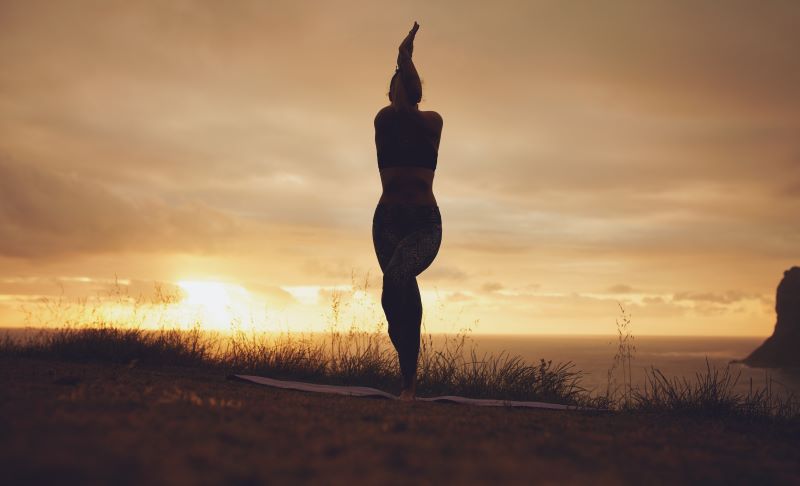
Garudasana, or the Eagle Pose, is one of the most productive standing yoga poses. While doing this posture for the first time, you will sense tightening or constriction. However, this is when you should push yourself and keep doing it because it will eventually ease your muscles and bring stability.
Nevertheless, before you decide to include Garudasan in your workout regime, you must learn about its health benefits, precautions, and the right steps to take.

Table of Contents

What is Garudasana (Eagle Pose)?
“Garuda” in Sanskrit stands for eagle, and “asana” means posture. The asymmetrical body position achieved from this asana is a representation of focus and strength. As this is an advanced-level exercise, you should gather adequate information before trying to ace it. Additionally, if anyone wants to improve their posture and balance, they can also try this.
How to Perform Garudasana?
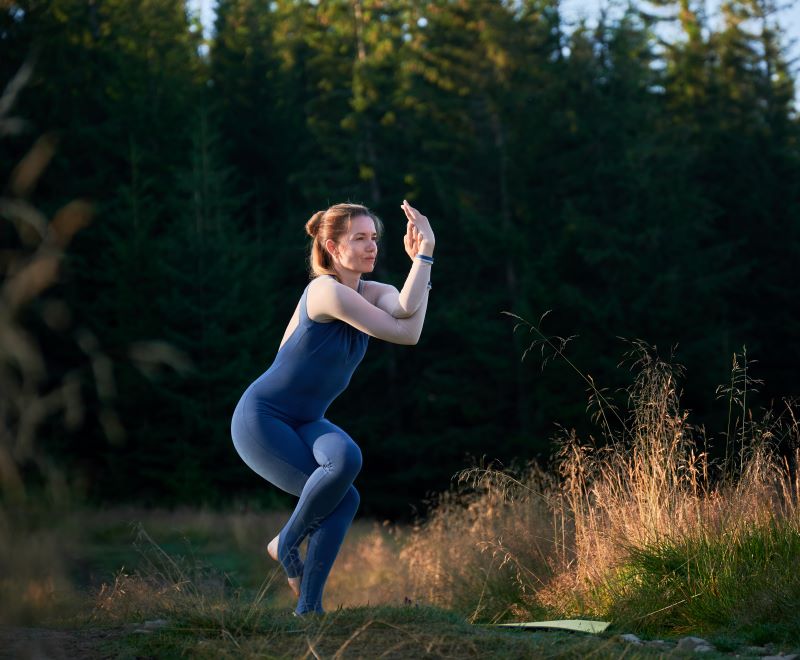
The procedure of Garudasana demands high focus and concentration because it is all about carefully balancing your whole body on one leg. So here are the steps to guide you through the process.
Step 1: Stand upright with your eyes focused at a point.
Step 2: Apply pressure to your right leg and bend your knees. You must feel an alternate force lifting your head to lengthen your spine.
Step 3: Take your left foot cross it over the right thigh and curl it up to fix it there. Make sure to point your left toes to the ground.
Step 4: Bring your arms forward and twist your left arm over your right. Then, move your right hand towards your face.
Step 5: Now cross your forearms and press palms; here, you will need to try to raise your elbows to your shoulder height.
Step 6: Hold on to this position for some time and sense the stretch in your spine.
Step 7: Slowly release your arms and legs and return to the first position to repeat the same with your other leg.
15 Health Benefits of Garudasana
As you can infer from the above section, one of the primary benefits of this posture is enhancing balance. It also helps you work on your focus and body posture. The Eagle Pose is also a good stretching exercise as it engages your whole body. In addition, it has the following advantages:
1. Improves Body Balance
Garudasana involves balancing your whole body on one leg. This exercise can help individuals who have lost coordination or stabilisation regain their balance.
2. Improves Focus
When you practise the Eagle Pose, you need to have immense focus and concentration to avoid losing balance. While remaining still in this pose, you also develop awareness and calmness of body and mind, elevating your mental attention span.
3. Enhances Flexibility
As our body consists of several joints and muscles, it is essential to maintain flexibility for better functioning. By doing this exercise, you can increase your body's flexibility and prepare yourself to sustain in any new situation or environment. Moreover, practising the Eagle Pose improves your reflexes alongside increasing flexibility.
4. Relieves Stress
One of the best advantages of Garudasana is that it relieves stress and tension from your body. As most people suffer from muscle stress and stiffness, it is necessary to untie those knots and ease the muscles. Although it will take some time to attain this, you need to keep practising in order to extract benefits from this yoga.
5. Treats Sciatica
Sciatica is the pain that mainly affects your back, hips and legs. This results from compressing the spinal nerve root of the lower back, which occurs mainly for sitting for long hours. So, when you practise the Eagle Pose, your lower back bones get toned, relieving your sciatica.
6. Strengthens Your Legs
When you are in this yoga pose, your body weight is put on one leg. This affects the lower leg bones, also known as the tibia and fibula. So, if you are looking for ways to tone your legs, this posture can be very effective. Furthermore, it also strengthens your legs.
7. Elongates Arms and Thighs
Our arms and thighs are the assets that help us move. Although they are always in motion, they need specific exercises to develop their strength. As you twist your legs and arms to correct your posture and balance, you also stretch these body parts, that eventually elongate your arms and thighs.
8. Improves Blood Circulation
The twisting and stretching in this yoga promotes better blood circulation. It also works wonders on your muscle cramps and stiffness. Hence, including this posture in your routine workout can help you perform daily activities efficiently.
9. Reduces Neck and Shoulder Pain
To strike the exact posture for this asana, you are required to stabilise your neck and shoulder. Thus, making Garudasana one of the best ways to treat a tight neck and shoulder.
10. Enhances Respiratory Function
Garudasana involves deep breathing, which enhances lung capacity and respiratory function. The pose's expansion and contraction of the chest encourage improved carbon dioxide release and oxygen intake, thus enhancing respiratory health in general.
11. Boosts Concentration and Mental Clarity
Garudasana requires focused concentration to maintain balance; this concentration and mental clarity are also improved. Regular practice of this pose fosters mental clarity and calmness as well as sharpens cognitive abilities.
12. Stimulates the Nervous System
Garudasana's complex movements and balance call for precise movements that stimulate the nervous system and enhance its functionality. In addition to promoting the general health of the nervous system, this stimulation can help reduce the symptoms of nervous disorders.
13. Tones Abdominal Organs
The compression and twisting involved in Garudasana massage the abdominal organs, promoting their health and function. This can aid in digestion, improve metabolism, and support overall organ health.
14. Increases Energy Levels
The combination of stretching, balancing, and deep breathing in Garudasana boosts energy levels and revitalizes the body and mind. Practising this pose regularly can help combat fatigue and improve overall vitality.
15. Promotes Emotional Balance
Garudasana helps release tension and stress from the body, promoting emotional balance and well-being. The meditative aspect of this pose calms the mind and reduces anxiety, promoting a sense of inner peace and harmony.
Other Benefits
As you twist your body, internal organs like the kidneys are squeezed. This helps with body detoxification.
Eagle Pose significantly improves the digestive system and controls bowel movement.
The Mudras of Garudasana (Eagle Pose)
In addition to the physical benefits, Garudasana also incorporates specific hand gestures, known as mudras, which further enhance the pose's therapeutic effects. These mudras help channel energy flow and deepen the mind-body connection. Here are the mudras commonly associated with Garudasana:
1. Garuda Mudra
Garuda Mudra, named after the mythical eagle Garuda, is formed by interlacing the fingers of both hands with palms facing each other. Extend the index fingers upward, resembling the wings of an eagle, while maintaining the pose. This mudra symbolises strength, unity, and balance, aligning with the characteristics of the Eagle Pose, Garudasana.
Benefits of Garuda Mudra: This mudra promotes balance, unity, and strength, aligning with the symbolism of the Eagle Pose. It enhances concentration, focus, and inner stability, fostering a sense of groundedness and empowerment.
2. Vayu Mudra
The gesture of air, Vayu Mudra, can be incorporated into Garudasana by bringing the tips of the index and thumb together on each hand to form a circle while the other fingers are kept extended. Throughout the pose, hold the mudra lightly to facilitate the flow of prana, or life energy, and to help you feel more focused and at ease.
Benefits of Gyan Mudra: This mudra helps alleviate gas-related issues like bloating and indigestion by regulating the air element in the body. It also calms the mind, reduces anxiety, and promotes inner peace and tranquillity.
Types of Garudasana
Garudasana provides variations to suit varying degrees of experience and adaptability. Selecting the best variation for your practice can be made easier if you are aware of the different forms of Garudasana. Here are the types:
1. Modified Garudasana
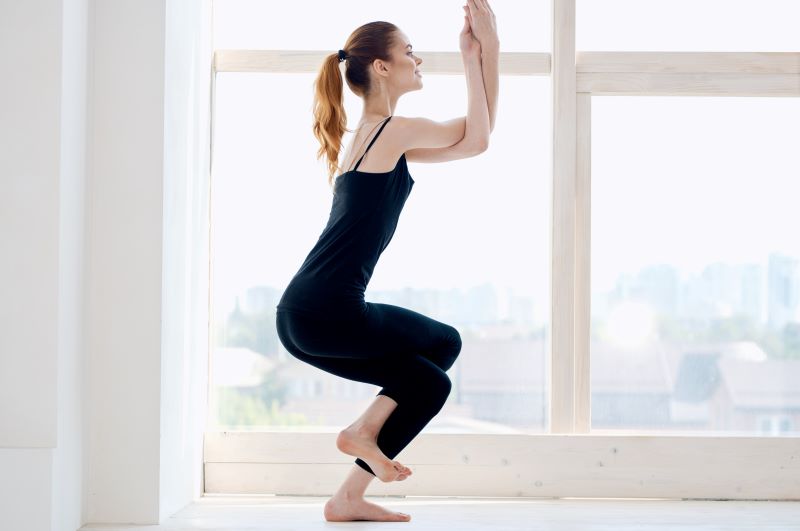
In Modified Garudasana, practitioners perform the Eagle Pose with a slight variation, such as keeping the lifted foot on the ground or bending a little for added stability. This modification is ideal for beginners or individuals with balance issues, allowing them to experience the benefits of Garudasana with greater ease.
2. Garudasana with Extended Arms
In Garudasana with extended arms, practitioners extend their arms outward to the sides, parallel to the ground, while maintaining the traditional leg position of the Eagle Pose. This variation intensifies the stretch in the shoulders and upper back, enhancing flexibility and releasing tension in the upper body.
3. Seated Garudasana

Seated Garudasana involves performing the Eagle Pose while seated on the floor or in a chair, rather than standing. This variation provides a gentle stretch for the hips, thighs, and lower back, making it suitable for individuals with mobility issues or those seeking a seated yoga practice.
4. Supta Parivrtta Garudasana (Reclining Eagle Spinal Twist)
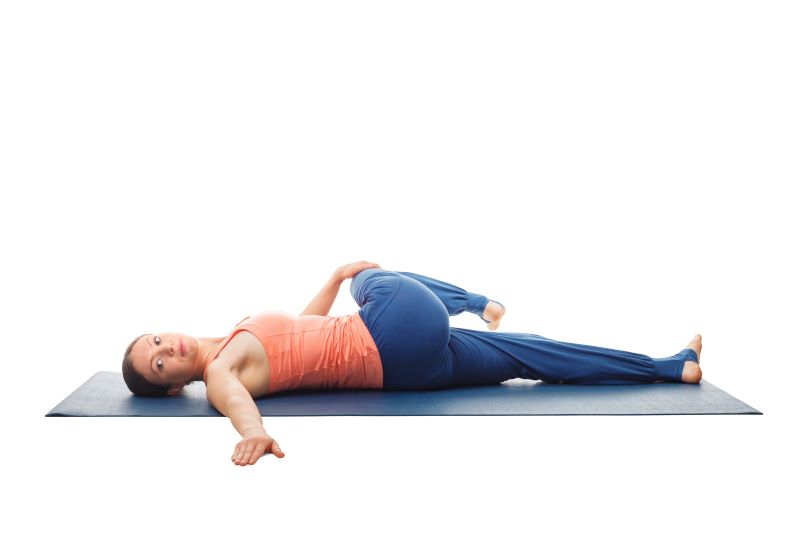
In Supta Parivrtta Garudasana, practitioners lie on their backs and bring one knee over the opposite leg, twisting the torso in the opposite direction. This variation combines the benefits of Garudasana with a spinal twist, promoting spinal mobility, releasing tension, and improving digestion.
Things to Know Before Doing Garudasana Yoga
Before attempting Garudasana, it's essential to understand its nuances and considerations for a safe and effective practice.
If you have any current medical conditions or injuries, speak with a trained yoga instructor or healthcare provider.
To get your body ready for the strenuousness of Garudasana, warm it up sufficiently with light stretches and movements.
To support the spine and keep your balance throughout the pose, concentrate on good alignment and contract your core muscles.
Although Garudasana may seem difficult at first, with regular practice, you can increase your strength and flexibility. Therefore, practice patience and persistence.
Listen to your body and honour its limitations, avoiding any movements or sensations that cause pain or discomfort.
How Long to Hold Garudasana Pose?
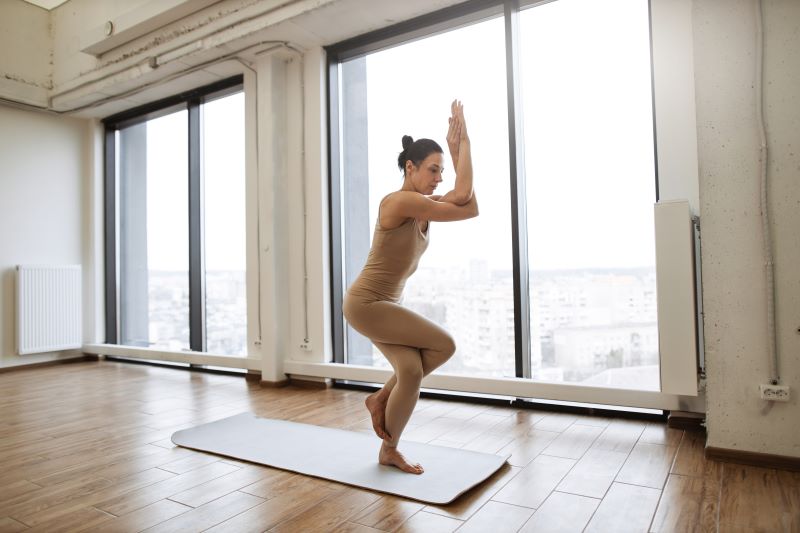
Garudasana duration varies based on practitioners' proficiency levels, ensuring safety and effectiveness in their yoga practice.
- For Beginners: Novice practitioners may start withholding Garudasana for 15-30 seconds on each side, gradually increasing the duration as comfort and stability improve.
- For Intermediate Practitioners: Intermediate practitioners can aim to hold Garudasana for 30-60 seconds on each side, focusing on maintaining proper alignment and breath awareness throughout the pose.
- For Advanced Practitioners: Advanced yogis may challenge themselves by holding Garudasana for 60 seconds or more on each side, deepening the stretch and further refining their balance and concentration skills.
Risks of Overdoing Garudasana
While Garudasana offers numerous benefits, overdoing it can lead to potential risks and adverse effects on the body.
- Muscle Strain: Excessive repetition or holding of the pose can strain the muscles, particularly in the shoulders, hips, and legs.
- Joint Discomfort: Overloading the joints, such as the knees and ankles, may lead to discomfort or exacerbate existing joint issues.
- Spinal Compression: Holding the pose for too long or with improper alignment can compress the spine, potentially leading to discomfort or injury.
- Nerve Compression: Prolonged compression of nerves, especially in the arms and legs, can result in tingling, numbness, or nerve-related symptoms.
- Reduced Blood Flow: Excessive constriction or compression in the pose may impede blood circulation, leading to sensations of coldness or numbness in the limbs.
- Increased Risk of Falls: Fatigue or loss of balance from overdoing Garudasana increases the risk of falls, potentially causing injuries such as sprains or fractures.
Important Tips for Practising Garudasana
If you are a beginner, here are some tips to help you practise the Eagle Pose.
Always do a warm-up session before doing the Garudasana.
Instead of hooking one leg onto another, you can cross your legs and use your bigger toe to press against the floor. This will work you up to maintain balance.
Make sure to press your hands flat against each other. However, if wrapping your arms is uncomfortable, place them on opposite shoulders.
You should keep your breathing regular; holding your breath is never recommended in this asana.
Stop practising this posture if you feel dizziness or pain.
It is important to do this asana on an empty stomach. You can eat for at least 4-6 hours before doing the Garudasana.
What are the Precautions and Contraindications of Garudasana?
Garudasana is a complex yoga posture; hence it is vital to be aware of its precautions and contraindications. If you have any of these medical conditions, you should refrain from practising this yoga.
Shoulder, elbow, knee or wrist injury
Twisted or enlarged veins
Arthritis
Knee pain
If you are pregnant, consult your doctor before trying this Eagle Pose.
Who Should Avoid Doing Garudasana?
While Garudasana offers numerous benefits, certain individuals may need to avoid or modify the pose to prevent potential discomfort or injury.
- Individuals with Knee or Ankle Injuries: Those with acute or chronic knee or ankle issues should avoid Garudasana to prevent exacerbating their condition.
- Pregnant Women: Pregnant women, especially those in the later stages of pregnancy, should avoid deep twists and compressive poses like Garudasana to ensure the safety of both mother and baby.
- People with High Blood Pressure: Holding the pose with compressed limbs during Garudasana can elevate blood pressure momentarily. People who have uncontrolled hypertension ought to refrain from striking this position.
- Those with Shoulder Injuries: Individuals with shoulder injuries or instability should approach Garudasana with caution or avoid it altogether to prevent aggravating their condition.
- People with Back Problems: To prevent strain on the spine, people with back problems, such as spinal stenosis, herniated discs, or persistent back pain, should avoid or modify the Garudasana.
While Gurudasana helps with flexibility and relaxation, it can be dangerous for some individuals. Hence, one must always have a health insurance policy at every stage of life to cover the medical expenses for any kind of treatment. This will help them solely focus on recovery without worrying about financial burden.
What are the Easy Modifications of Garudasana?
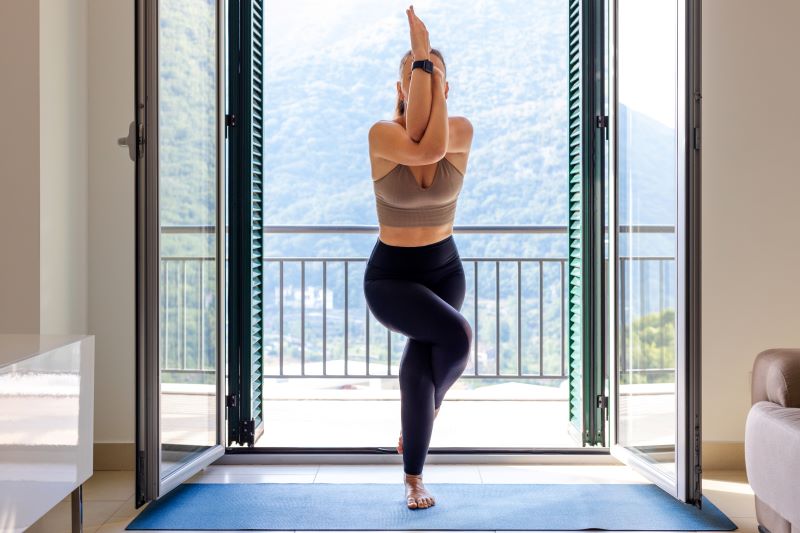
This section is especially for those who are just beginning to learn the Eagle Pose. You can try these easy modifications to become more familiar with the pose.
You can use a wall to rest your back for the first few times. Once you gain more confidence, try balancing without the wall.
If you find it tough to hook your lifted foot, place a block under it. Use this as a kickstand.
Another way to try the Eagle Pose is by sitting on a chair.
Apart from the multiple health benefits of Garudasana, it is one of the most effective stretching exercises. It can strengthen your back, hips, shoulders, thighs, and calves. Further, it maintains adequate blood circulation and clears your mind to improve focus and concentration. So, if you have read the entire write-up, you now know how to get started with this exercise.










